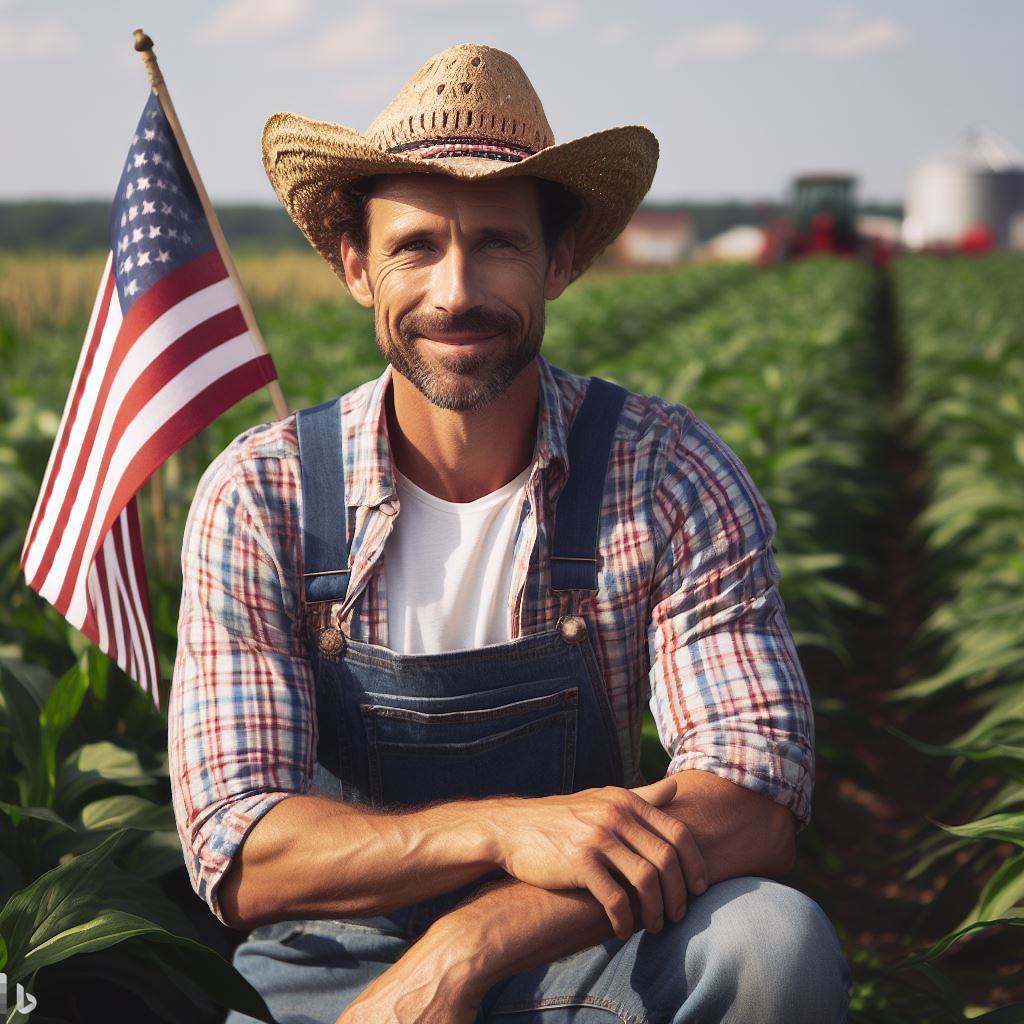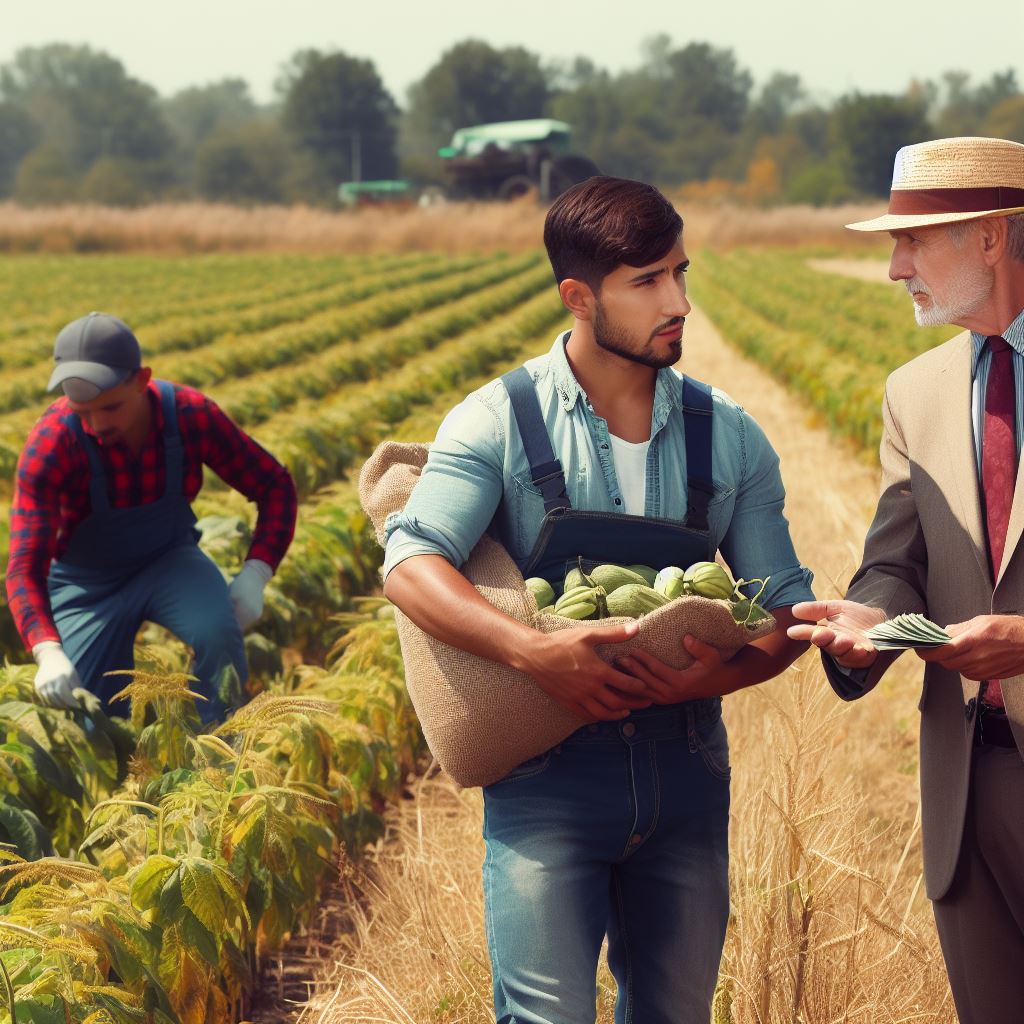Introduction
In the heartland of America, where fields stretch to the horizon and crops sway in the breeze, farmers face an intricate challenge that transcends the boundaries of their fields.
It’s a dilemma that has become central to their way of life – the quest to harmonize profit and stewardship.
This section sets the stage for our exploration of this enduring predicament, delving into the complexities and nuances that American farmers confront.
At its core, this dilemma revolves around the delicate art of maintaining agricultural practices that are economically viable while preserving the environment for future generations.
The fertile soils and bountiful harvests should not come at the cost of ecological sustainability.
We aim to dissect the strategies, struggles, and innovations that shape the lives of farmers as they navigate this complex terrain.
In the sections that follow, we will traverse the various dimensions of this intricate issue, offering insights, solutions, and a deeper understanding of the farmer’s predicament.
This journey will take us through the intricate dance between profit and stewardship, illuminating the challenges and opportunities that exist in American agriculture.
So, join us on this exploration as we uncover the multifaceted world of balancing profit and stewardship among US farmers.
The Importance of Profit in Farming
The economic aspect of farming and the need for profitability
- Farming is not just an occupation but also a business that requires financial success.
- Profitability is essential for farmers to sustain their operations and livelihood.
- Agricultural production and economic growth are interconnected, driving the need for profitability.
- Farmers rely on profits to reinvest in their farms, improve technology, and increase productivity.
- Profit allows farmers to afford new equipment, buy necessary supplies, and cover operating costs.
The challenges faced by farmers in ensuring profitability
- Farmers are constantly exposed to unpredictable factors such as weather, pests, and diseases.
- Fluctuating market prices make planning and budgeting difficult, affecting income stability.
- High costs of inputs, such as seeds, fertilizers, pesticides, and machinery, impact profitability.
- Farmers need to manage risks through crop diversification and efficient resource utilization.
- Limited access to capital and credit hinders investment in technology and infrastructure.
Various income sources for farmers
- Farmers can generate income through the sale of their agricultural produce in domestic and international markets.
- Diversification into value-added products like organic farming or specialty crops can increase profitability.
- Direct-to-consumer sales channels, such as farmers’ markets or farm-to-table programs, offer higher prices.
- Alternative income sources like agritourism, on-farm events, or farm stays attract additional revenue.
- Government subsidies, grants, and support programs can assist farmers in facing economic challenges.
Farmers must strike a balance between maintaining profitability and being responsible stewards of the land.
By adopting sustainable practices, they can reduce costs, increase efficiency, and protect the environment.
Efforts like water conservation, soil health management, and crop rotation contribute to long-term profitability.
Collaborative approaches, such as cooperative partnerships or joint marketing, can help overcome financial obstacles.
Basically, profitability is the lifeblood of farming, enabling farmers to provide food security and environmental sustainability.
While challenges persist, innovative strategies and support systems can empower farmers to achieve economic success.
The Significance of Stewardship in Farming
The concept of stewardship in the context of agriculture
Stewardship in agriculture refers to the responsible management and care of farmland and resources. As stewards, farmers take on the role of caretakers, ensuring the long-term viability of their land.
They are tasked with optimizing production while minimizing the negative impact on the environment.
Farmers must carefully balance their economic interests with the need for environmental sustainability.
The importance of sustainable farming practices
Sustainable farming practices are crucial for the future of agriculture and the well-being of the planet.
By implementing sustainable practices, farmers can minimize soil erosion, preserve water quality, and reduce pollution.
Sustainability helps safeguard the land’s productivity, ensuring its capability to meet growing food demands.
It also promotes biodiversity and protects the natural habitats of various plant and animal species.
The role of farmers in conserving natural resources and protecting the environment
Farmers play a vital role in conserving natural resources and safeguarding the environment.
They adopt practices like crop rotation, cover cropping, and integrated pest management to enhance soil health.
By using precision agriculture techniques, farmers optimize fertilizer and pesticide applications, minimizing wastage.
Efficient irrigation systems and water-saving practices are employed to ensure water conservation.
Transform Your Career Today
Unlock a personalized career strategy that drives real results. Get tailored advice and a roadmap designed just for you.
Start NowThrough responsible waste management and recycling, farmers reduce the environmental impact of their operations.
The challenges faced by farmers in achieving sustainable stewardship
Despite the significance of stewardship, farmers face several challenges in achieving sustainable practices.
Economic pressures often prioritize short-term profits over long-term sustainability goals.
Lack of knowledge or access to sustainable farming techniques can hinder implementation.
External factors like unpredictable weather patterns and pests can pose obstacles to stewardship efforts.
Additionally, the transition to sustainable practices may require financial investments that not all farmers can afford.
Examples of successful stewardship initiatives in farming
Despite the challenges, many farmers have successfully embraced sustainable stewardship initiatives.
Agroforestry, where trees and crops are integrated, has proven to enhance biodiversity, soil health, and carbon sequestration.
Cover cropping, using crops like clover or grasses, helps prevent soil erosion, increase organic matter, and reduce the need for fertilizers.
Precision agriculture technologies enable farmers to tailor inputs, reducing resource wastage while maintaining productivity.
Community-supported agriculture (CSA) models promote sustainable farming practices and connect consumers directly to local farmers.
Essentially, stewardship in farming is of utmost importance in achieving sustainable agriculture.
By adopting responsible practices, farmers can ensure the long-term viability of their land while protecting the environment.
Efforts to conserve natural resources, promote biodiversity, and minimize pollution are crucial for the future of farming.
Read: Postgraduate Pathways for Ag Engineers in the United States
Key Factors Influencing Profit and Stewardship
The role of market demand and pricing in determining profit
- Market demand plays a crucial role in determining the profitability of farmers. It influences the prices they can command for their products.
- Farmers need to understand market trends and consumer preferences in order to align their production to meet the demand.
- Pricing strategies are important for farmers to ensure they receive fair compensation for their products while remaining competitive in the market.
- By understanding and responding to market demand, farmers can maximize their profit potential and ensure the sustainability of their operations.
The impact of weather conditions on farming sustainability and profitability
- Weather conditions have a significant impact on farming sustainability and profitability.
- Extreme weather events, such as droughts or floods, can lead to crop loss, reduced yields, and increased expenses for farmers.
- Changes in precipitation patterns and temperature fluctuations can also affect the productivity and health of crops and livestock.
- Farmers must adapt to climate change by implementing sustainable practices, using irrigation systems, and investing in infrastructure to mitigate the impact of weather conditions.
- Managing risks associated with weather is crucial for farmers to maintain profitability and ensure the long-term sustainability of their farms.
Government policies and regulations affecting both profit and stewardship
- Government policies and regulations have a significant impact on both the profitability and stewardship practices of farmers.
- Policies related to agricultural subsidies, trade agreements, and import/export regulations can influence market prices and farmers’ ability to compete.
- Environmental regulations, such as water usage restrictions and pesticide use guidelines, aim to protect natural resources and promote sustainable farming practices.
- Compliance with these regulations can sometimes lead to additional costs for farmers, impacting their profitability.
- However, government programs can also provide incentives and support for farmers to adopt sustainable practices and improve their stewardship.
- Collaborations between governments, farmers, and other stakeholders are essential to develop policies that balance profit and stewardship effectively.
Generally, market demand and pricing, weather conditions, and government policies and regulations are key factors influencing both the profitability and stewardship practices of US farmers.
Farmers can achieve a profit-stewardship balance by grasping market trends, adjusting to weather challenges, and adhering to regulations, securing sustainability.
Read: Networking & Growth: Professional Bodies for Ag Engineers in USA
Challenges and Dilemmas Faced by US Farmers
The Conflict Between Maximizing Productivity and Ensuring Sustainable Practices
The US farming industry faces a constant dilemma of balancing profit and stewardship. Farmers are under pressure to maximize productivity to meet the growing food demand.
However, this conflicts with the need to ensure sustainable farming practices, as overuse of resources and chemicals can harm the environment.
Farmers often find themselves torn between using intensive farming methods to increase yields and preserving the land for future generations.
The pressure to meet the rising food demand can lead to unsustainable practices, such as excessive pesticide use or over-irrigation.
Showcase Your Business Today
Reach thousands of readers actively exploring professional services. Publish your business profile and grow your audience now.
Publish NowTo address this conflict, farmers are increasingly adopting sustainable farming techniques.
They are implementing precision agriculture to optimize resource use and reduce environmental impact.
This includes using data-driven technology to monitor soil health, applying precise amounts of fertilizers and pesticides, and practicing crop rotation.
However, implementing these sustainable practices can present financial challenges.
The Financial Burden of Adopting Environmentally Friendly Measures
Adopting environmentally friendly measures often comes with a significant financial burden for US farmers.
Transitioning to sustainable practices requires investments in new technologies, equipment, and training. While these measures have long-term benefits, the upfront costs can be daunting for many farmers.
For smaller-scale farmers or those with limited access to credit, investing in sustainable farming techniques becomes even more challenging.
The initial expenses for equipment upgrades or transition to organic farming may not be financially viable for them.
Moreover, some sustainable practices, such as organic farming, can reduce yields in the short-term.
This can further strain the financial viability of farmers who rely on steady profits to support their families and operations.
To alleviate the financial burden, farmers need access to financial assistance programs and grants specifically targeted at promoting sustainable agriculture.
Government support, private partnerships, and cooperative efforts can help farmers transition to sustainable practices without jeopardizing their financial stability.
The Pressure to Meet Market Demands While Adhering to Stewardship Principles
US farmers face immense pressure to meet market demands for affordable and high-quality food products. Consumers expect a consistent supply of food, regardless of the challenges farmers face.
However, this demand often conflicts with the principles of stewardship and sustainable farming.
To keep up with market demands, farmers may resort to intensive farming practices.
This can involve the use of genetically modified organisms (GMOs), synthetic fertilizers, and antibiotics.
While these practices maximize productivity, they raise concerns about the long-term effects on human health and the environment.
Moreover, farmers face market pressures to produce specific crops, strains, or varieties, limiting diversity in agriculture.
This not only affects the resilience of the food system but also hampers biodiversity and increases the risk of crop failures due to pests, diseases, and climate change.
Balancing market demands with stewardship principles requires collaboration and education.
Farmers need support to diversify their crops, adopt sustainable practices, and gain access to alternative markets that value environmentally friendly products.
Consumer awareness and demand for sustainable food can also incentivize farmers to prioritize stewardship without sacrificing profitability.
In a nutshell, US farmers face numerous challenges and dilemmas in balancing profit and stewardship.
The conflict between maximizing productivity and ensuring sustainable practices, the financial burden of adopting environmentally friendly measures.
And the pressure to meet market demands while adhering to stewardship principles are just a few examples.
Addressing these challenges requires collaborative efforts between farmers, policymakers, and consumers to create a sustainable and profitable agricultural system.
Read: Innovative Projects Shaping US Agricultural Engineering

Discover More: Role of Genetics in US Animal Breeding Practices
Strategies for Balancing Profit and Stewardship
Examples of Sustainable Farming Techniques to Enhance Profit
- Implementing crop rotation to optimize soil health and reduce the need for synthetic fertilizers.
- Adopting precision agriculture technologies to improve irrigation efficiency and minimize water waste.
- Utilizing integrated pest management practices to reduce chemical pesticide use and production costs.
- Installing renewable energy systems such as solar panels or wind turbines to reduce energy expenses.
- Implementing agroforestry techniques that combine crops with trees to increase yield and diversify income streams.
By applying sustainable farming techniques like crop rotation, precision agriculture, and integrated pest management, farmers can enhance their profitability while being good stewards of the land.
These practices optimize soil health, reduce chemical inputs, and minimize environmental impacts.
Additionally, implementing renewable energy systems on farms can further reduce operating costs and contribute to sustainable agricultural practices.
Importance of Diversification and Exploring Niche Markets
- Diversifying crops and products can mitigate risks associated with market fluctuations and climate variability.
- Exploring niche markets, such as organic or locally sourced products, can yield higher prices and demand.
- Developing value-added products, like jams or artisanal cheese, can increase profit margins and consumer appeal.
- Engaging in agritourism activities, such as on-farm events or educational tours, can generate additional income.
- Participating in farmers’ markets or joining Community-Supported Agriculture (CSA) programs to access direct consumer sales.
Diversification plays a crucial role in balancing profit and stewardship.
By diversifying their crops and products, farmers effectively spread their risks and can adapt to changing market conditions.
Moreover, exploring niche markets such as organic or locally sourced products can yield premium prices and cater to consumer preferences for sustainable and ethical farming practices.
Developing value-added products or engaging in agritourism activities can provide additional revenue streams beyond traditional commodity production.
Benefits of Collaborating with Local Communities and Sharing Resources
- Establishing partnerships with nearby farmers can facilitate joint purchasing and bargaining power for inputs.
- Sharing equipment, machinery, and infrastructure can reduce individual investment costs and boost overall efficiency.
- Forming cooperatives or farmer associations enables collective marketing efforts and negotiating fair prices.
- Engaging in community-supported agriculture can foster customer loyalty and provide a stable market for produce.
- Collaborating with local schools or organizations to provide educational programs can enhance community relationships.
Collaboration and resource-sharing within local communities are essential strategies for farmers to achieve a profitable and sustainable balance.
By partnering with neighboring farmers, they can collectively purchase inputs at lower costs, increasing their bargaining power.
Sharing equipment, machinery, and infrastructure among farmers not only reduces individual expenses but also promotes resource efficiency and minimizes duplicate investments.
Forming cooperatives or farmer associations enables collective marketing efforts, allowing farmers to negotiate fair prices and reach broader markets.
Initiatives such as community-supported agriculture create a direct link between farmers and consumers, fostering trust, loyalty, and a stable market for produce.
Beyond economic benefits, collaborating with local communities and sharing resources can strengthen social bonds and create a sense of belonging.
Working with schools or organizations to provide educational programs on sustainable farming practices helps raise awareness and build lasting relationships with consumers, neighbors, and future generations.
To sum it up, achieving a balance between profit and stewardship is a complex but critical task for US farmers.
Sustainable farming techniques, diversification, exploring niche markets, and collaborating with local communities are all strategies that can help farmers achieve this delicate equilibrium.
By adopting these practices, farmers can thrive financially while preserving the environment, promoting community well-being, and ensuring a sustainable future for agriculture.
Read: Sustainability Focus: How Ag Engineers Shape US Farms
Case Studies of Successful Balancing Efforts
Present real-life examples of farmers who have achieved a balance between profit and stewardship
- John Anderson, a farmer from Iowa, has successfully balanced profit and stewardship by implementing sustainable farming practices.
- Sarah Davis, a farmer from California, is another example of achieving a balance between profit and stewardship on her organic farm.
- Tom Thompson, a farmer from Kansas, has incorporated conservation techniques while maintaining profitability on his family farm.
The strategies implemented by these farmers and the outcomes achieved
- John Anderson has embraced cover cropping and crop rotation, reducing soil erosion and improving water retention. As a result, he has increased crop yields and reduced the need for chemical fertilizers.
- Sarah Davis has implemented integrated pest management strategies, reducing pesticide use and promoting the natural balance of pests and beneficial insects on her farm. This has resulted in healthier crops and reduced environmental impact.
- Tom Thompson has adopted precision agriculture techniques, utilizing data-driven tools to optimize the use of fertilizer and irrigation. This has led to improved efficiency, cost savings, and reduced environmental footprint.
The impact of their efforts on their communities and the environment
- John Anderson’s sustainable farming practices have not only improved the productivity of his own farm but have also inspired neighboring farmers to adopt similar techniques. This has led to a thriving farming community that prioritizes environmental stewardship.
- Sarah Davis’s organic farm has become a model for sustainable agriculture in her region. Local farmers have visited her farm to learn about organic farming methods, leading to a growing network of environmentally conscious farmers.
- Tom Thompson’s precision agriculture techniques have reduced the runoff of excess fertilizers and improved water quality in nearby streams. His farm’s success has prompted other farmers in the area to invest in modern technologies, resulting in a positive impact on the entire community.
On a final note, these case studies demonstrate that achieving a balance between profit and stewardship is possible for farmers.
Through implementing sustainable practices, such as cover cropping, integrated pest management.
Also, in precision agriculture, these farmers have successfully improved both their financial returns and their environmental impact.
Additionally, their efforts have had a positive ripple effect on their communities, inspiring and empowering other farmers to adopt similar strategies.
By prioritizing both profitability and stewardship, farmers can contribute to a more sustainable and resilient agricultural system.
Conclusion
In this blog post, we have explored the dilemma faced by US farmers in balancing profit and stewardship on their farms.
We discussed how farmers strive to maximize their profits while also ensuring the sustainable use of resources.
It is crucial to find a balance between profit and stewardship in farming. Farmers play a crucial role in providing food for the growing population while also being stewards of the land and environment.
As readers, we can support sustainable farming practices by being conscientious consumers.
We should consider the choices we make, such as buying locally grown produce and supporting organic farming methods.
By doing so, we contribute to the preservation of our environment and the sustainability of the farming industry.
To summarize, the dilemma faced by US farmers in balancing profit and stewardship is a complex issue that requires careful consideration and action from all stakeholders.
It is essential to recognize the importance of sustainable farming practices and the impact our choices as consumers can have on the agricultural industry.
Let us strive to support and promote a sustainable future for farming.
[E-Books for Sale]
The Big Book of 500 High-Paying Jobs in America: Unlock Your Earning Potential
$19.99 • 500 High-Paying Jobs • 330 pages
Explore 500 high-paying jobs in America and learn how to boost your career, earn more, and achieve success!
See All 500 High-Paying Jobs of this E-Book
1001 Professions Without a Degree: High-Paying American Jobs You Can Start Now
$19.99 • 1001 Professions Without a Degree • 174 pages
Discover 1001 high-paying jobs without a degree! Unlock career tips, skills, and success strategies for just $19.99!




